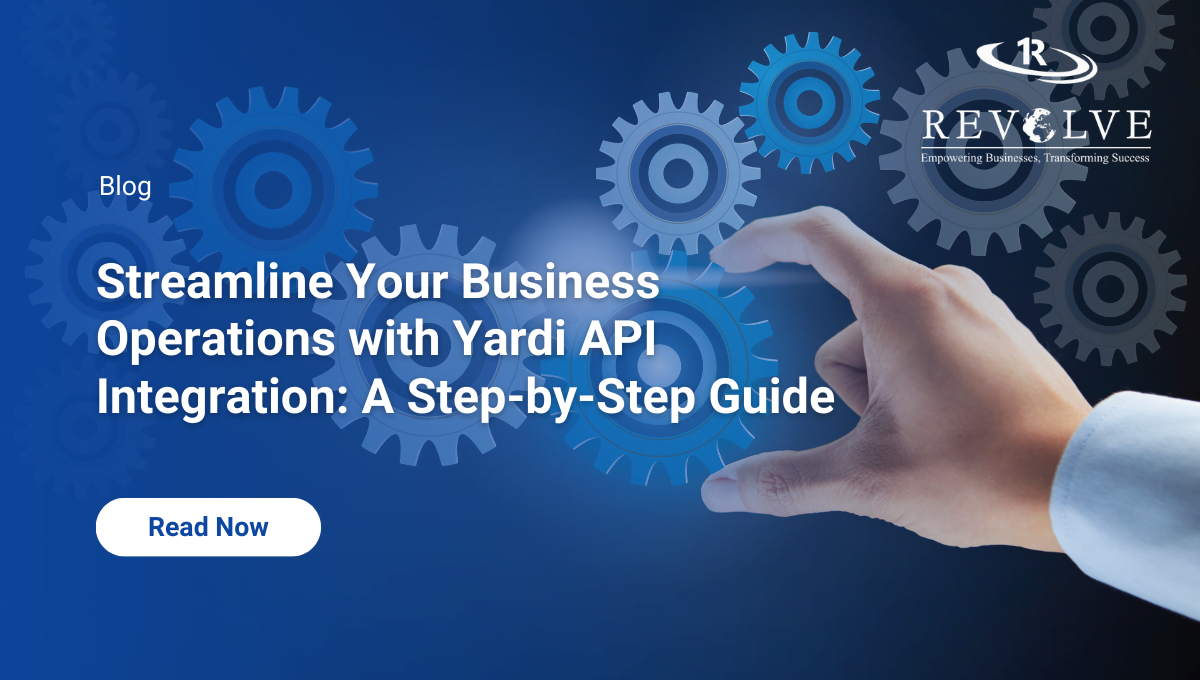Streamline Your Business Operations with Yardi API Integration: A Step-by-Step Guide
Understanding Yardi API Integration:
As businesses continue to evolve in the digital age, it is crucial to harness the power of technology to streamline operations and improve efficiency. One such technology that has gained significant traction is Yardi API Integration. In this comprehensive guide, we will delve into the world of Yardi API Integration, why it is important for businesses, and how it can revolutionize your operations.
At its core, Yardi API Integration refers to the seamless connection between Yardi software and other applications or systems through Application Programming Interfaces (APIs). This integration enables businesses to automate and synchronize data across various platforms, eliminating the need for manual data entry and reducing the risk of errors.
Why Yardi API Integration is important for businesses:
Yardi API Integration offers numerous benefits for businesses across industries. Firstly, it allows for real-time data synchronization, ensuring that information is always up to date and accurate. This is particularly crucial in industries such as property management, where timely access to data can make a significant difference in decision-making and customer service.
Additionally, Yardi API Integration enhances operational efficiency by automating processes and eliminating manual data entry. This not only saves time but also reduces the likelihood of human error. By streamlining operations, businesses can allocate resources more effectively, focus on core activities, and ultimately drive growth.
Furthermore, Yardi API Integration enables businesses to leverage the power of third-party applications and systems. This means that you can seamlessly connect Yardi software with other tools, such as CRM or accounting software, to create a unified ecosystem that caters to your specific needs. This integration empowers businesses to leverage the strengths of multiple platforms and maximize productivity.
Benefits of streamlining business operations with Yardi API Integration
Implementing Yardi API Integration can yield a multitude of benefits for businesses. Firstly, it improves data accuracy and integrity by eliminating the need for manual data entry and reducing the risk of human error. This ensures that decision-making is based on reliable and up-to-date information, leading to better outcomes.
Moreover, Yardi API Integration enhances efficiency by automating repetitive tasks and workflows. This frees up valuable time for employees to focus on strategic activities that drive business growth. By reducing manual intervention, businesses can also minimize the likelihood of errors, resulting in cost savings and improved customer satisfaction.
Another key benefit of Yardi API Integration is the ability to centralize data and create a unified view of your operations. By connecting Yardi software with other systems, you can aggregate data from various sources into a single dashboard or interface. This holistic view enables businesses to gain valuable insights, identify trends, and make informed decisions.
Step-by-step guide to implementing Yardi API Integration
Now that we understand the importance and benefits of Yardi API Integration, let’s dive into a step-by-step guide on how to implement it in your business. By following these steps, you can ensure a smooth and successful integration process.
- Identify your integration requirements: Begin by assessing your business needs and determining which systems or applications you want to integrate with Yardi software. This will help you prioritize integration efforts and identify the necessary APIs to achieve your goals.
- Research Yardi API options: Familiarize yourself with the available Yardi APIs and their capabilities. Yardi offers a range of APIs, including ones for property management, accounting, and CRM. Explore the documentation and resources provided by Yardi to understand how these APIs can be leveraged to streamline your specific business operations.
- Select a Yardi API Integration solution: Once you have identified your integration requirements and explored the available APIs, it’s time to choose the right integration solution for your business. There are various integration platforms and tools available in the market that specialize in Yardi API Integration. Evaluate their features, pricing, and customer reviews to make an informed decision.
- Plan your integration strategy: Before diving into the integration process, it is essential to develop a comprehensive integration strategy. Define the scope of the integration, set realistic timelines, and allocate appropriate resources. Consider involving key stakeholders and IT professionals to ensure a smooth implementation.
- Test and validate the integration: Once the integration is set up, thoroughly test and validate the connection between Yardi software and the integrated systems or applications. Conduct end-to-end testing to ensure data accuracy, functionality, and performance. Address any issues or bugs that arise during this stage.
- Monitor and maintain the integration: Integration is an ongoing process that requires monitoring and maintenance. Regularly check the integration to ensure data synchronization, resolve any potential issues, and optimize performance. Keep track of system updates and new API releases from Yardi to stay up to date with the latest features and improvements.
By following these steps, you can successfully implement Yardi API Integration in your business and unlock its full potential.
Choosing the right Yardi API Integration solution for your business
Selecting the right Yardi API Integration solution is crucial for a successful integration process. With many options available, it is important to consider several factors before deciding.
- Compatibility: Ensure that the integration solution you choose is compatible with your existing systems and applications. It should seamlessly connect with Yardi software and provide the necessary functionalities to meet your integration requirements.
- Scalability: Consider the scalability of the integration solution. As your business grows, you may need to integrate additional systems or applications. Choose a solution that can accommodate future expansion and easily integrate with new platforms.
- Security: Data security is of utmost importance when integrating systems. Evaluate the security measures implemented by the integration solution provider to protect your data. Look for features such as encryption, access controls, and regular security audits.
- Support and documentation: Choose an integration solution that offers comprehensive support and documentation. This will ensure that you have access to resources, tutorials, and assistance whenever needed. Prompt and reliable support can make a significant difference in the success of your integration.
- Cost and ROI: Evaluate the pricing structure of the integration solution and consider the return on investment (ROI) it can deliver. Look for solutions that offer competitive pricing, transparent pricing models, and the potential for long-term cost savings through increased efficiency.
By carefully considering these factors and conducting thorough research, you can choose the right Yardi API Integration solution that aligns with your business needs and goals.
Common challenges and how to overcome them during Yardi API Integration
While Yardi API Integration offers immense benefits, it is not without its challenges. Understanding and addressing these challenges can help ensure a smooth integration process. Here are some common challenges and strategies to overcome them:
- Data mapping and transformation: Integrating different systems often involves mapping and transforming data from one format to another. This can be complex, especially when dealing with large volumes of data. To overcome this challenge, invest in integration solutions that offer robust data mapping capabilities and provide support for data transformation.
- System compatibility: Integrating systems from different vendors may present compatibility issues. To address this, thoroughly assess the compatibility of the integration solution with your existing systems. Engage with the solution provider to understand potential challenges and ensure that the integration is seamless.
- Data security: The integration of systems raises concerns about data security. To mitigate this risk, implement strict access controls, encryption mechanisms, and regular security audits. Work closely with both Yardi and the integration solution provider to establish secure data transfer protocols.
- Change management: Implementing Yardi API Integration may require changes to existing processes and workflows. Resistance to change can be a challenge. To overcome this, clearly communicate the benefits of integration to stakeholders, provide training and support, and involve key stakeholders in the integration process.
By proactively addressing these challenges, you can minimize disruptions and maximize the benefits of Yardi API Integration in your business.
Best practices for successful Yardi API Integration
To ensure a successful Yardi API Integration, it is essential to follow best practices. Here are some key practices to consider:
- Define clear integration goals: Clearly define your integration goals and objectives before embarking on the integration process. This will help guide your efforts and ensure that the integration aligns with your business strategy.
- Plan for scalability: Anticipate future needs and plan for scalability from the outset. Choose an integration solution that can accommodate future growth and easily integrate with new systems or applications.
- Conduct thorough testing: Thoroughly test the integration to ensure data accuracy, functionality, and performance. Conduct both unit testing and end-to-end testing to identify and address any issues before deploying the integration.
- Document the integration process: Document the integration process, including configuration settings, mappings, and any customizations. This documentation will serve as a valuable resource for future reference and troubleshooting.
- Regularly monitor and optimize: Regularly monitor the integration to ensure data synchronization, identify potential issues, and optimize performance. Stay up to date with new releases and updates from Yardi to leverage the latest features and improvements.
By following these best practices, you can maximize the success of your Yardi API Integration and reap its full benefits.
Yardi API Integration tools and resources
To simplify the process of Yardi API Integration, numerous tools and resources are available. These tools offer pre-built integrations, connectors, and APIs that can streamline the integration process. Some popular Yardi API Integration tools include:
- Revolve Solutions: Revolve Solutions specializes in Yardi API Integration and offers a range of tools and services to simplify the integration process. Their expertise can help businesses seamlessly connect Yardi software with other systems or applications.
- Yardi Marketplace: Yardi Marketplace is an online platform that offers a wide range of applications and services specifically designed for Yardi software. These applications often come with built-in integrations, making the integration process easier and more efficient.
- Yardi API documentation: Yardi provides comprehensive documentation and resources for their APIs, including technical guides, sample code, and best practices. These resources are invaluable for developers and integration teams looking to leverage Yardi APIs.
By utilizing these tools and resources, businesses can streamline the Yardi API Integration process and accelerate the implementation timeline.
Wrapping Up
Yardi API Integration offers a powerful solution for streamlining business operations and improving efficiency. By seamlessly connecting Yardi software with other systems or applications, businesses can automate processes, enhance data accuracy, and gain valuable insights. With a step-by-step guide, best practices, and a range of tools and resources available, implementing Yardi API Integration has never been easier. Embrace the power of Yardi API Integration today and revolutionize your business operations. Book a demo today at sales@revolvespl.com

